Slow-Motion Memoir: An Illustrated History, installment #44.
 1973: At left, one of the only jobs I ever drew featuring children; probably one of those situations which have happened throughout my life where I was asked if I could draw something I hadn’t tried before, and I responded “Why not? Let me give it a try.” Looking at the printed copy of the illustration now, it’s obvious I lifted the figures, quite literally, from HOW TO DRAW CHILDREN, one of the many How To Draw… instruction manuals by creative entrepreneur Walter T. Foster (1891-1981) who created a whole line of them in the early 50s. I received HOW TO DRAW CHILDREN as a birthday or Christmas present, probably in my 10th year (for lack of a clearer memory). On my own I acquired two others: HOW TO DRAW HORSES and HOW TO DRAW CARTOONS (Disney style). I can still remember the specially-made metal-wire racks that housed a selection of Foster’s numerous manuals, in a local stationery & book-store in nearby Biddeford, one of the only places where I truly loved to shop. HOW TO DRAW… Animals, Dogs, Fashion, the Figure, Funnies, the Head, Trees: all volumes soft covered, 8-1/2″ x 14″, 40 pages, staple-bound, and selling for $1.00. In that same startionery store I also bought my first Hardy Boy book, and my first LP, aka ‘vinyl’ (and it wasn’t even stereo, it was monaural): Tchaikovsky’s Nutcracker and Swan Lakes Suites, played by Eugene Ormandy and the Philadelphia Orchestra. The books on drawing children and horses are still in my library; the Hardy Boys series and the LPs are all gone. The manual on drawing cartoons? who knows whither or whence? Sometimes I wonder if I shouldn’t have stuck with cartooning…
1973: At left, one of the only jobs I ever drew featuring children; probably one of those situations which have happened throughout my life where I was asked if I could draw something I hadn’t tried before, and I responded “Why not? Let me give it a try.” Looking at the printed copy of the illustration now, it’s obvious I lifted the figures, quite literally, from HOW TO DRAW CHILDREN, one of the many How To Draw… instruction manuals by creative entrepreneur Walter T. Foster (1891-1981) who created a whole line of them in the early 50s. I received HOW TO DRAW CHILDREN as a birthday or Christmas present, probably in my 10th year (for lack of a clearer memory). On my own I acquired two others: HOW TO DRAW HORSES and HOW TO DRAW CARTOONS (Disney style). I can still remember the specially-made metal-wire racks that housed a selection of Foster’s numerous manuals, in a local stationery & book-store in nearby Biddeford, one of the only places where I truly loved to shop. HOW TO DRAW… Animals, Dogs, Fashion, the Figure, Funnies, the Head, Trees: all volumes soft covered, 8-1/2″ x 14″, 40 pages, staple-bound, and selling for $1.00. In that same startionery store I also bought my first Hardy Boy book, and my first LP, aka ‘vinyl’ (and it wasn’t even stereo, it was monaural): Tchaikovsky’s Nutcracker and Swan Lakes Suites, played by Eugene Ormandy and the Philadelphia Orchestra. The books on drawing children and horses are still in my library; the Hardy Boys series and the LPs are all gone. The manual on drawing cartoons? who knows whither or whence? Sometimes I wonder if I shouldn’t have stuck with cartooning…
 Truth to tell, I’ve realized through this review that my fashion illustration style is more derivative of certain realistic cartoon-strip styles that I grew up with, than I had realized previously. The more realistically drawn narrative strips like Mark Trail, Prince Valiant, Steve Canyon, Mary Worth, among others, all captured my imagination as a child becoming a teenager, avidly taking in the daily page of funnies in the Portland Press Herald. There was magic in drawing, and I recognized it. Walter Foster’s How To Draw manuals were designed to give the aspiring artist a sense of proportion. It worked for me. I copied, and probably traced, a good many of the figures from my three manuals, giving me an early grounding in human, as well as horse and cartoon, proportions that has stayed with me over the years. Consider the illustration above, which was created as a double-spread for a catalog published by The Merchandising Group in ’73; an interesting treatment of breaking the page up into smaller boxes — a variation on comic-strip, or story-board style — each unit telling its own story.
Truth to tell, I’ve realized through this review that my fashion illustration style is more derivative of certain realistic cartoon-strip styles that I grew up with, than I had realized previously. The more realistically drawn narrative strips like Mark Trail, Prince Valiant, Steve Canyon, Mary Worth, among others, all captured my imagination as a child becoming a teenager, avidly taking in the daily page of funnies in the Portland Press Herald. There was magic in drawing, and I recognized it. Walter Foster’s How To Draw manuals were designed to give the aspiring artist a sense of proportion. It worked for me. I copied, and probably traced, a good many of the figures from my three manuals, giving me an early grounding in human, as well as horse and cartoon, proportions that has stayed with me over the years. Consider the illustration above, which was created as a double-spread for a catalog published by The Merchandising Group in ’73; an interesting treatment of breaking the page up into smaller boxes — a variation on comic-strip, or story-board style — each unit telling its own story.
 Mirror imaging was another technique I employed frequently, made easier by acquiring a light box for the studio, so tracing with alterations became a way of quickly creating a new illustration when I was under the gun to knock out a bunch of figures, like the ones above. One learns shortcuts as a commercial artist with timelines and deadlines to deal with. Free-lancing provided me with an amazing education!
Mirror imaging was another technique I employed frequently, made easier by acquiring a light box for the studio, so tracing with alterations became a way of quickly creating a new illustration when I was under the gun to knock out a bunch of figures, like the ones above. One learns shortcuts as a commercial artist with timelines and deadlines to deal with. Free-lancing provided me with an amazing education!



{ 0 comments… add one now }